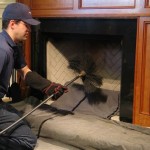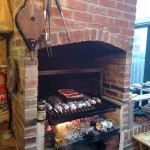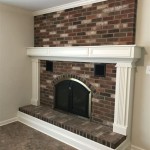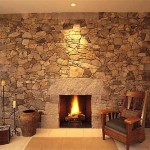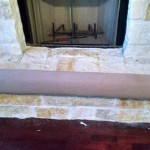Gas Fireplace No Flue: An Overview
Gas fireplaces offer a convenient and aesthetically pleasing alternative to traditional wood-burning fireplaces. Among the various types available, the gas fireplace no flue, also often referred to as a ventless or unvented gas fireplace, presents a unique solution for homeowners seeking the ambiance of a fire without the complexities of installing a chimney or vent system. This article will explore the functionality, advantages, considerations, and safety aspects of gas fireplaces that operate without a flue.
The core principle behind a gas fireplace without a flue lies in its near-complete combustion process. Unlike traditional gas fireplaces, which expel combustion byproducts, these units are designed to burn fuel almost entirely, minimizing the release of harmful emissions into the indoor environment. This efficient combustion process relies on advanced burner technology and careful control of the air-to-fuel ratio. The byproduct of this combustion is primarily carbon dioxide and water vapor, the latter of which can contribute to increased humidity levels within the space.
The absence of a flue significantly simplifies installation. Traditional fireplaces necessitate the construction or modification of a chimney to safely vent exhaust gases. This process can be costly and disruptive, particularly in existing homes. Ventless gas fireplaces, however, eliminate this requirement, allowing for installation in a wider range of locations, including rooms without existing chimneys or exterior walls. This adaptability makes them a popular choice for renovations, additions, and situations where a traditional fireplace is not feasible.
Gas fireplaces without a flue are typically fueled by either natural gas or propane. The choice between these fuels depends on factors such as availability, cost, and existing fuel infrastructure. Natural gas is generally more economical in areas where it is readily available via a utility connection. Propane, on the other hand, offers greater flexibility as it can be stored in tanks and used in areas without natural gas service. The fuel source will determine the unit's BTU (British Thermal Unit) output, which directly correlates to its heating capacity.
Maintenance for a gas fireplace without a flue is generally less demanding than that of a wood-burning fireplace. There is no need to clean out ashes or creosote buildup. However, regular inspections are crucial to ensure proper functioning and safety. These inspections should include checking the burner for any obstructions, cleaning the glass door, and verifying the integrity of the gas lines. Furthermore, professional servicing by a qualified technician is recommended on a periodic basis.
Key Point 1: Functionality and Combustion Process
The operational mechanism of a gas fireplace no flue hinges on a carefully engineered combustion process. These units are designed to achieve a high level of combustion efficiency, typically exceeding 99%. This efficiency is accomplished through advanced burner designs that ensure optimal mixing of fuel and air. The burner typically incorporates numerous small ports or jets that distribute the gas evenly, promoting complete and clean burning. The resulting flame is then directed towards ceramic logs or other decorative elements, creating the visual effect of a traditional fire.
The combustion process generates heat, which is radiated into the room. The amount of heat produced is determined by the unit's BTU rating. BTU is a measure of the amount of energy needed to raise the temperature of one pound of water by one degree Fahrenheit. A higher BTU rating indicates a greater heating capacity. Selecting a unit with an appropriate BTU rating for the size of the room is crucial for achieving comfortable heating without overheating the space.
As previously mentioned, the primary byproducts of combustion are carbon dioxide and water vapor. While these byproducts are generally considered harmless in small quantities, excessive levels of carbon dioxide can lead to drowsiness or headaches, and elevated humidity levels can promote mold growth. To mitigate these risks, it is essential to operate the fireplace in a well-ventilated area and to follow the manufacturer's instructions regarding usage limitations.
Most gas fireplaces without a flue are equipped with safety features, such as an oxygen depletion sensor (ODS). The ODS monitors the oxygen levels in the room and automatically shuts off the gas supply if the oxygen level drops below a certain threshold. This safety mechanism prevents carbon monoxide poisoning, which can occur if the fireplace is operated in a poorly ventilated space and the combustion process becomes incomplete.
Another important aspect of the functionality of these fireplaces is the control system. Many models feature electronic ignition systems that allow for push-button or remote control operation. These systems often include features such as adjustable flame height and thermostat control, providing users with greater flexibility in managing the heat output and ambiance of the fireplace.
Key Point 2: Advantages and Limitations
The primary advantage of a gas fireplace without a flue is the ease of installation. The absence of a chimney or vent system eliminates the need for extensive construction or modifications to the building structure. This makes them an attractive option for retrofitting existing homes or installing a fireplace in areas where a traditional fireplace is not feasible. The installation process typically involves connecting the unit to a gas supply line and securing it in place. In many cases, the installation can be completed in a matter of hours, significantly reducing the time and cost associated with traditional fireplace installations.
Another advantage is the cost-effectiveness of operation. Gas fireplaces are generally more efficient than wood-burning fireplaces, meaning they convert a higher percentage of the fuel's energy into heat. This can result in lower heating bills, particularly in homes where the fireplace is used as a primary or supplemental heating source. Furthermore, the absence of a chimney eliminates the heat loss associated with traditional fireplaces, further improving energy efficiency.
Aesthetically, gas fireplaces without a flue offer a wide range of design options. They are available in various styles, sizes, and finishes to complement any décor. Many models feature realistic-looking ceramic logs that mimic the appearance of a wood-burning fire. Other options include glass beads, river rocks, or other decorative elements. The availability of diverse designs makes it possible to create a custom look that reflects the homeowner's personal preferences.
Despite these advantages, gas fireplaces without a flue also have certain limitations. One limitation is the potential for increased humidity levels within the room. As mentioned earlier, water vapor is a byproduct of combustion. While small amounts of water vapor are generally not a problem, excessive humidity can lead to mold growth and other moisture-related issues. Therefore, it is important to monitor humidity levels and ensure adequate ventilation, especially during prolonged use.
Another limitation is the potential for indoor air quality concerns. While these fireplaces are designed to burn fuel efficiently, they are not completely emission-free. Small amounts of pollutants, such as nitrogen dioxide and carbon monoxide, may be released into the environment. These pollutants can pose a health risk, especially to individuals with respiratory problems or sensitivities. To mitigate this risk, it is crucial to operate the fireplace in a well-ventilated space and to have it inspected and serviced regularly by a qualified technician.
Key Point 3: Safety Considerations and Regulations
Safety is paramount when it comes to operating any gas appliance, and gas fireplaces without a flue are no exception. It is essential to adhere to the manufacturer's instructions and to follow all applicable safety guidelines. One of the most important safety precautions is to ensure adequate ventilation. The fireplace should never be operated in a confined space with limited airflow. Proper ventilation helps to dilute any pollutants that may be released and prevents the buildup of carbon dioxide and other gases.
Regular maintenance is also crucial for ensuring safe operation. The burner should be inspected regularly for any obstructions, such as dust, lint, or debris. These obstructions can interfere with the combustion process and lead to incomplete burning, which increases the risk of carbon monoxide poisoning. The glass door should also be cleaned periodically to remove any soot or buildup. A qualified technician should inspect and service the fireplace at least once a year to ensure that all components are functioning properly.
Carbon monoxide detectors are an essential safety device for any home with a gas fireplace. These detectors monitor the levels of carbon monoxide in the air and sound an alarm if dangerous levels are detected. Carbon monoxide is a colorless, odorless gas that can be deadly. It is produced when fuel is burned incompletely. Carbon monoxide detectors should be installed in accordance with the manufacturer's instructions and should be tested regularly to ensure that they are functioning properly.
Local building codes and regulations may also impose specific requirements for the installation and operation of gas fireplaces without a flue. These regulations may address issues such as ventilation, clearances from combustible materials, and the presence of carbon monoxide detectors. It is important to check with the local building department to ensure that the fireplace meets all applicable requirements.
Furthermore, it is important to be aware of the potential hazards associated with propane gas. Propane is a highly flammable gas that can explode if handled improperly. Propane tanks should be stored in a safe location, away from heat sources and ignition sources. The gas lines should be inspected regularly for leaks. If a gas leak is suspected, the gas supply should be turned off immediately, and a qualified technician should be called to repair the leak.

How To Vent A Gas Fireplace Without Chimney Vertical Care

Fires Choices For Homes Without Chimneys Wakefords Fireplaces And Stoves

Studio Edge

No Chimney Problem Wood Burning Stoves Electric Hole In The Wall Fires Can I Have A Stove Without Bespoke Fireplaces Made To Measure
:max_bytes(150000):strip_icc()/ventless-gas-fireplaces-4160746-hero-f9d4bdcd9bd446eb84406de306f790ba.jpg?strip=all)
How To Pick Out A Ventless Gas Fireplace

The Ekofires 5510 Inset Flueless Gas Fire Direct Fireplaces

Ventless Gas Fireplace Propane

What Is A Ventless Gas Fireplace Experts In Gaithersbutg Md

Can I Have A Stove Without Chimney Stovax Gazco

Do Gas Fireplaces Need A Chimney Dreifuss
Related Posts

